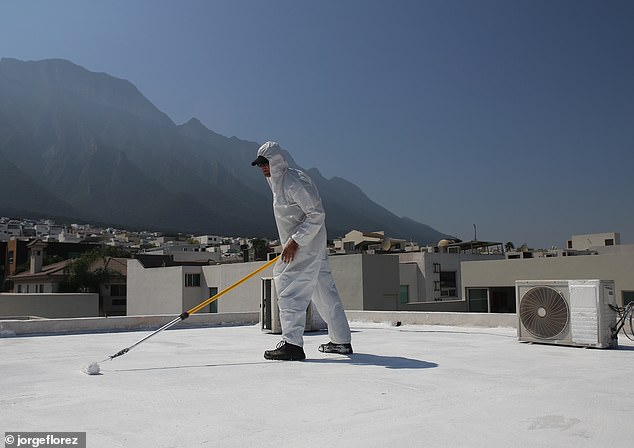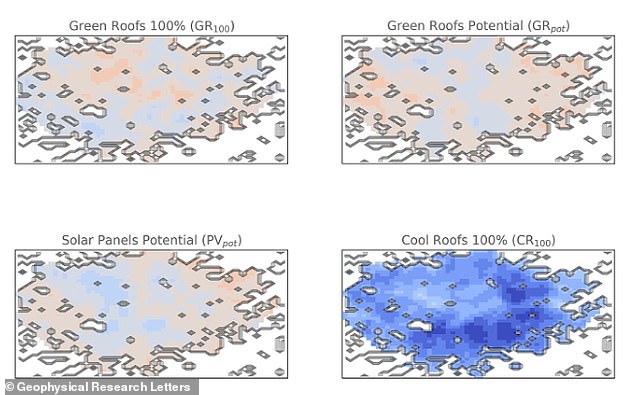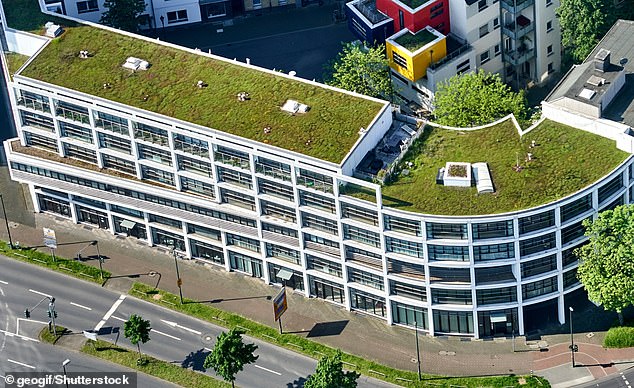Could white paint save London from climate change? According to a study, all of the city’s roofs could be covered in a reflective coating to keep residents cool during a heatwave
Scientists are already convinced that London is unprepared for higher temperatures in the future due to climate change.
This is because the city’s buildings and infrastructure have traditionally been built to retain heat rather than release it.
But experts may have found the best solution: painting all of the city’s roofs white to reflect sunlight.
Scientists from University College London say white roofs would cool the city more effectively than solar panels or ‘green roofs’ covered with plants.
Some of the whitest paints in the world reflect almost all sunlight, meaning buildings absorb less solar energy and are therefore cooler.
Scientists already believe London is unprepared for a future of higher temperatures because the city’s buildings and infrastructure have historically been built to insulate heat, not dissipate it.

Painting roofs white or covering them with a reflective coating would be more effective at cooling all major cities, including London, the study found. Pictured, a worker applies a white coating to roofs in a hot climate
The new research was led by Dr Oscar Brousse, a climate scientist at UCL’s Bartlett School of Environment, Energy and Resources.
“We have extensively tested different methods that cities like London can use to adapt to and mitigate global warming,” he said.
‘(We) discovered that cool roofs are the best way to keep temperatures down during extremely hot summer days.
‘Other methods had several important additional benefits, but none could reduce outdoor heat in urban areas to nearly the same level.’
White painted roofs, also known as ‘cool’ roofs, are already found in countries that are traditionally warmer than the UK. However, there is a general lack of ‘cooling strategies’ as the debate over their effectiveness is ‘currently ongoing’.

‘Cool roofs’ (painted white) are the best way to beat the heat in London, according to new research from UCL

‘Green roofs’ (those covered with vegetation) provide habitats for wildlife and convert CO2 into oxygen, but the modelling study found they did not reduce overall temperatures in London. Pictured is a green roof in Düsseldorf, Germany
To find out more, the team used an urban computer model to run 3D simulations of extreme heat in Greater London.
The temperatures in the simulation were set for the two hottest days of summer 2018, when the British Isles suffered a scorching heatwave that led to drought, hosepipe bans, crop failures and wildfires.
‘The model represents the impact of buildings and streets in three dimensions and takes into account the interactions between the indoor and outdoor environments,’ Dr Brousse told MailOnline.
On average, white roofs reduced temperatures in London by about 1.2°C.
White roofs had a greater cooling capacity than solar panels (which provided a reduction of about 0.5°C/0.9°F) and also than ‘street level vegetation’ such as trees and shrubs (0.3°C/0.54°F).
And while green roofs provide benefits such as water drainage and wildlife habitat, their average net cooling effect on the city was found to be zero.
Meanwhile, air conditioning – which transports heat from indoors to outdoors – would warm London by about 0.27°F (0.15°C) for the city as a whole, but by as much as 1.8°F (1°C) in densely populated central London.

View of the ‘Bosco Verticale’ and ‘Unicredit Tower’ – skyscrapers in Porta Nuova, the business district of Milan, Italy. Plant-covered buildings help capture carbon
However, the team adds that solar panels could potentially provide enough energy to run air conditioning throughout London, creating “comfortable indoor environments”.
As the climate changes, city dwellers are particularly vulnerable to rising temperatures, not just in London but in many densely populated cities such as Paris, Beijing and Los Angeles.
Cities tend to trap heat, creating the urban heat island effect, which can lead to increased discomfort and mortality.
“Higher mortality rates and a greater likelihood of thermal discomfort are generally observed during warm periods,” the team said in their study, published in Geophysical research letters.
Last year, a report found that at least 61,000 people died from heatwaves across Europe in the summer of 2022, including 3,469 in the UK.
